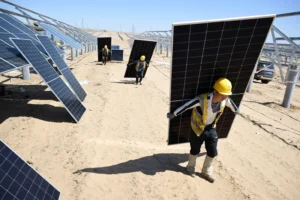As temperature records are shattered, ice rapidly melts and extreme weather events worsen, many people around the world say they are feeling more worried about climate change.
Researchers call this growing phenomenon “climate anxiety”.
A new analysis examines 94 studies focused on climate anxiety, involving 170,000 people across 27 countries, to explore who it is most likely to affect and what its possible consequences could be.
It finds that those who are more likely to experience climate anxiety include women, young adults, people with “left-wing” views and those expressing “concerns” about nature or the “future”.
Climate anxiety is negatively related to wellbeing, according to the analysis, but positively related to participating in climate action, such as activism and behaviours to reduce emissions.
Below, Carbon Brief explains the findings in more detail.
- What is ‘climate anxiety’?
- Who suffers from climate anxiety?
- What are the consequences of climate anxiety?
- How does climate anxiety differ from general anxiety?
What is ‘climate anxiety’?
“Climate anxiety” can be described and defined in various ways.
The research, published in the journal Global Environmental Change, considers the term “climate change anxiety” to “broadly refer to people’s feelings of anxiety and/or worry related to climate change”.
This is based on two established definitions, explains study lead author Dr Clara Kühner, a researcher of climate change and psychology at the University of Leipzig, Germany. She tells Carbon Brief:
“There is a discussion in the scientific community about what exactly constitutes climate change anxiety.”
The first definition comes from a 2023 research paper, which describes climate anxiety as “persistent anxiety (apprehensiveness) and worry about climate change”.
The second comes from the American Psychological Association, which in 2020 used the term “eco anxiety” to describe “any anxiety or worry about climate change and its effects”.
Kühner explains that “eco anxiety could be interpreted as being more broadly related to the ecological crisis…but [the American Psychological Association] describe it as any anxiety or worry related to climate change”.
Her team noticed that there has been an “increasing amount of research” into climate anxiety over the past few years, she adds:
“Research on the topic has exploded. That’s a signal that it’s very relevant to researchers, but also to society and the public.
“But it was very difficult to get an overview of this research because it was scattered across different disciplines, not only psychology, but also public health and sociology. And so it was difficult to really know how much is out there. That’s when we thought: ‘OK, let’s put all of that together in a quantitative meta-analysis to get an overall perspective on the topic.’”
For the meta-analysis, Kühner and her team searched online records, scoured scientific conference agendas and contacted other scientists to try to identify all published and upcoming studies looking into climate anxiety.
They focused on studies that had conducted surveys with people self-reporting symptoms of climate anxiety. They also restricted their search to “correlational studies” looking at the links between self-reported climate anxiety and various factors, such as gender, age or political beliefs.
In addition, they only included studies involving people over the age of 18.
In total, the meta-analysis identifies 94 climate anxiety studies, involving 170,000 people in 27 countries.
Some 81 of these studies were published after 2020, according to the researchers – reflecting the surge of research interest into the topic over the past few years.
Who suffers from climate anxiety?
As part of the meta-analysis, the researchers looked across the 94 studies to identify what characteristics are most highly associated with having climate anxiety.
From this, the meta-analysis finds that those more likely to report feeling climate anxiety include:
- Younger adults
- Women
- People with a “left-wing” political orientation
- People concerned about the environment
- People concerned about nature
- People concerned about the future
- People who believe in climate change
- People who have been exposed to climate impacts
- People who are regularly exposed to information about climate change (such as climate scientists, journalists and teachers)
The graphic below shows the relative “effect size” of each of these characteristics, according to the study, with -0.9 illustrating the trait is less related to climate anxiety and 0.9 indicating it is more related.
On the graphic, the centre of each blue bar represents the effect size, with the start and end showing 95% confidence intervals.
By contrast, people with the opposite characteristics to those listed above – for example, those that are older, male or hold “right-wing” political views – are less likely to report feeling climate anxiety, according to the research.
The study only examines the correlations between feeling climate anxiety and various human characteristics – and does not look into the reasons why different groups of people may be more likely to experience climate anxiety.
One of the research papers cited in the meta-analysis finds that people under the age of 25 who reported climate anxiety were likely to have feelings of “betrayal” aimed towards older generations and to perceive governmental response to climate change as “inadequate”.
On gender, previous research – not cited in the meta-analysis – has found that women are more likely than men to suffer from mental illness following extreme weather events – and face higher health risks from climate change in general.
The meta-analysis does not look into how being transgender or non-binary could be associated with climate anxiety, but researchers have previously argued that these groups – along with other people who might identify as LGBTQ+ – are likely to face disproportionate climate risks.
The meta-analysis also does not investigate where in the world levels of climate anxiety could be the highest.
Most of the papers included in the meta-analysis were conducted in the global north.
Out of the 94 studies, 56 were conducted in Europe, 12 in North America, seven in Australia and New Zealand, seven in Asia, one in Africa and one in South America. (A further 10 spanned multiple continents.)
This “largely reflects the general dominance of western research in mainstream psychological and behavioural studies” – rather than a weakness of the authors’ methods, says Prof Kim-Pong Tam, an environmental psychologist from the Hong Kong University of Science and Technology, who was not involved in the meta-analysis.
He describes the findings as “very significant”, adding:
“It should be noted that the pattern revealed in this meta-analysis does not necessarily indicate that the phenomenon of interest has rarely been studied in the global south or outside of western societies.
“It is common practice for authors conducting a meta-analysis to focus on publications in the language(s) in which they are proficient. This implies that studies published in non-English languages (usually in local journals), if any, are excluded.”
Dr Charles Ogunbode, an associate professor in psychology specialising in how people respond to environmental change at the University of Nottingham, UK, agrees that the “lack of studies from Africa and other parts of the global south is not a unique weakness of this article”.
He says that the “climate anxiety discourse is western-centric”, explaining:
“Outside of western cultures, climate anxiety may not feel like an especially useful concept for making sense of local lived realities. For example, one study found that feelings of anger and grief regarding climate change are more prominent in Turkey. Another study conducted with young people in three African countries found the predominant emotions to be akin to a helpless pessimism. Similar observations were made in Ecuador.
“It is, of course, valuable to have a comprehensive study on climate anxiety, but the western-centric nature of the concept means that we end up missing out on the nuanced cross-cultural dimensions of emotional responses to climate change.”

What are the consequences of climate anxiety?
As well as examining what human characteristics are most associated with climate anxiety, the meta-analysis explores what consequences are most associated with the phenomenon.
These consequences are grouped into three categories: “wellbeing”, “climate change emotions” and “behaviour”. (The meta-analysis considers “wellbeing” to be “how individuals evaluate the quality of their own lives, including experiences such as life satisfaction”.
The meta-analysis finds that feeling climate anxiety is associated with poor wellbeing and negative feelings about climate change.
However, climate anxiety is also associated with “pro-environmental behaviours”, such as saving energy at home, as well as participating in community activism and showing support for government pro-climate policies. Kühner explains:
“We found that climate change anxiety is a double-edged sword. It [is] related to poorer wellbeing and to more psychological strain. On the other hand, it [is] positively related to different forms of pro-environmental behaviour.
“On the one hand, it could make you feel uncomfortable. But, on the other hand, it may trigger significant action.”
How does climate anxiety differ from general anxiety?
One of the goals of the meta-analysis is to investigate if climate anxiety is a distinct psychological phenomenon – or merely reflects the broader recent trend of rising levels of anxiety across many parts of the world, particularly for younger demographics.
To do this, the researchers carried out a “meta-regression analysis”, a statistical method for, in this case, investigating the size of the impact of various factors on having climate anxiety.
This analysis finds that the characteristics associated with climate anxiety, such as being a young adult or female, as well as its associated consequences, such as taking action to reduce emissions, were “uniquely related to climate anxiety above and beyond generalised anxiety”. Kühner explains:
“From a methodological point of view, this means that these are distinct constructs, not that people who are generally more anxious are also more anxious about climate change.”
This finding could have implications for how both medical professionals and the public view climate anxiety, she continues:
“Sometimes, climate change anxiety is treated like a disease that has to be cured. And it’s not. It’s a normal healthy reaction to an actual threat.
“I think it’s important for policymakers, also journalists and politicians, not to pathologise climate change anxiety, but to interpret it as a functional reaction to something that is actually happening. Instead of offering mental-health support for how to get rid of this, we need more opportunities to channel this anxiety into climate change action.”
In some cases, climate anxiety can cause poor mental health, she adds:
“If [climate anxiety] impairs your daily functioning or affects your sleep, you definitely need mental-health support to cope with these strong emotions.”
In the UK, mental-health support is available from the NHS by calling 111, the charity Mind is also available on 0300 123 3393. In the US, call or text Mental Health America at 988 or chat 988lifeline.org. In Australia, support is available at Beyond Blue on 1300 22 4636, Lifeline on 13 11 14 and at MensLine on 1300 789 978.
The post Explainer: What is ‘climate anxiety’? appeared first on Carbon Brief.
Greenhouse Gases
Analysis: Record UK wildfires have burned an area twice the size of Glasgow in 2025
Wildfires have scorched more than 40,000 hectares of land so far this year across the UK – an area more than twice the size of the Scottish city of Glasgow.
This is already a record amount of land burned in a single year, far exceeding the previous high, Global Wildfire Information System (GWIS) data shows.
It is also almost four times the average area burned in wildfires by this stage of the year over 2012-24 – and 50% higher than the previous record amount burned by this time in 2019.
The burned area overtook the previous annual record in April, BBC News reported at the time, and has continued to soar in the months since.
Major wildfires
The chart below shows that UK wildfires in 2025 so far have already burned by far the largest area of land over any calendar year since GWIS records began in 2012. The previous record year was 2019, followed by 2022, while 2024 saw the lowest area size burned.

Annual land area burned by wildfires across the UK from 2012 to 2025 (red), alongside the average area burned each year over 2012-24. Source: Global Wildfire Information System.
Climate change can increase the risk and impact of wildfires. Warmer temperatures and drought can leave land parched and dry out vegetation, which helps fires spread more rapidly. Climate change is making these types of extreme conditions more likely to occur, as well as more severe.
Fire services in England and Wales responded to 564 wildfires from January to June 2025 – an increase from 69 fires in the same period last year, the National Fire Chiefs Council (NFCC) said in a statement in June.
Most wildfires in the UK are caused by human activity, whether accidental or deliberate, according to the NFCC. Some common ignition sources are disposable barbecues, lit cigarettes and campfires.
Jessica Richter, a research analyst at Global Forest Watch, says that, while fires are also a key part of some ecosystems, climate change is the “major driver behind the increasing fire activity around the globe”. She tells Carbon Brief:
“As we see more fires, we’re going to see more carbon being emitted and that’s just going to be, for lack of a better phrasing, adding fuel to the fire.”
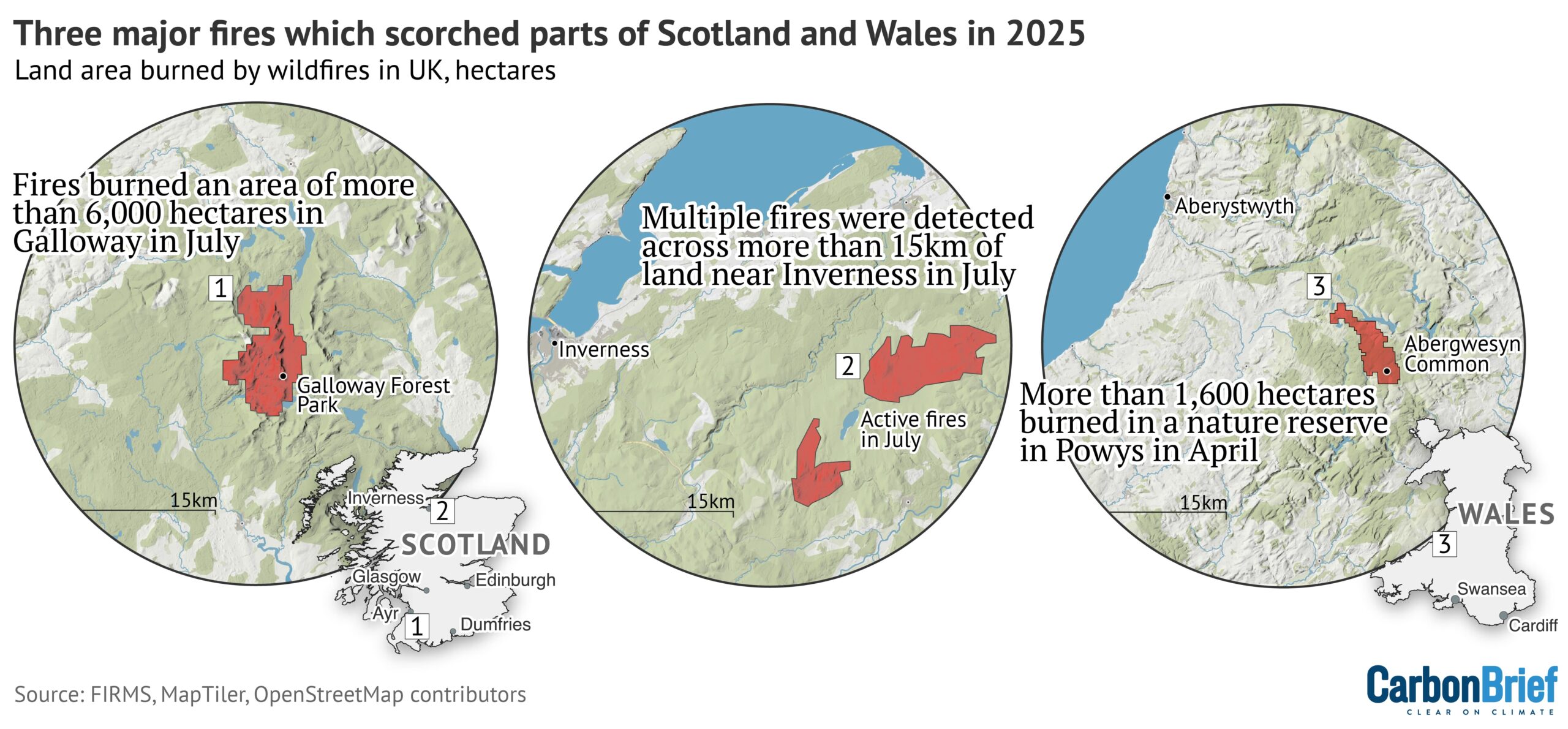
Examples of 2025 wildfires around Galloway (1) and Inverness (2) in Scotland, and a wildfire in Powys (3) in Wales. Source: FIRMS, MapTiler, OpenStreetMap contributors.
The UK has also recorded its highest-ever wildfire emissions this year, according to Copernicus, which was “primarily driven” by major wildfires in Scotland from late June to early July.
These were the largest wildfires ever recorded in the country, reported the Scotsman. They “ravaged” land in Moray and the Highlands in the north of the country, the newspaper added.
Scotland experienced an extreme wildfire in Galloway Forest Park in April, which was “so intense it could be seen from space”, the Financial Times said.
Elsewhere, in April, the Belfast News Letter reported that firefighters tackled almost 150 fires on the Mourne Mountains in Northern Ireland.
More recently, BBC News reported that firefighters in Dorset, England received “non-stop” wildfire calls in the first weekend of August, with one blaze “engulf[ing] an area the size of 30 football pitches”.
Wildfires have also caused devastation across many parts of Europe in recent weeks – including Albania, Cyprus, France, Greece, Spain and Turkey – as well as in the US and Canada.
The post Analysis: Record UK wildfires have burned an area twice the size of Glasgow in 2025 appeared first on Carbon Brief.
Analysis: Record UK wildfires have burned an area twice the size of Glasgow in 2025
Greenhouse Gases
DeBriefed 8 August 2025: Arctic heatwave; Climate anxiety deep-dive; France’s wildfire crisis
Welcome to Carbon Brief’s DeBriefed.
An essential guide to the week’s key developments relating to climate change.
This week
Global extremes
RECORD HEAT: Multiple countries experienced record heat this week. Nordic countries were hit by a “truly unprecedented” heatwave, where temperatures reached above 30C in the Arctic Circle and Finland endured three straight weeks with 30C heat, its longest heat streak in records going back to 1961, said the Guardian. Reuters reported that the United Arab Emirates (UAE) is facing “surging temperatures this summer”, following its hottest spring ever.
FIRE WEATHER: Some 81 million Americans were under air quality alerts as hundreds of wildfires burned across Canada and parts of the US, reported the Guardian. Meanwhile, a “massive” wildfire in California has “become the biggest blaze in the state so far this year” amid an intensifying heatwave, reported the Associated Press.
TORRENTIAL RAIN: A “torrent of mud” has killed at least four people in the northern Himalayan state of Uttarakhand, Reuters reported. According to the Times of India, “more than one cloudburst” hit the high-altitude district of Uttarkashi on Tuesday, triggering flash floods. It added that cloudburst risks in the Himalayan region are “projected to increase with climate change”. Meanwhile, Taiwan News said that “torrential rain in central and southern Taiwan over several days has left three dead, four missing, 49 injured and prompted 85 rescues”. Flash floods in a Myanmar-China “border town” have killed six people, according to the Straits Times.
Around the world
- COP30 CHAOS: After significant delays and pressure from a UN committee, Brazil has finally launched the official accommodation platform for COP30, Climate Home News reported. It added that “significant markups and sky-high prices remained”.
- MORE TARIFFS: Donald Trump has increased tariffs on imports from India to 50% as “punishment” for the country buying Russian oil, the New York Times reported.
- CORAL BLEACHING: The Guardian said that the Great Barrier Reef suffered its biggest annual drop in live coral since 1986 in two out of the three areas that are monitored by scientists..
- ENDANGERED: Top scientific advisers in the US have announced that they will “conduct an independent, fast-track review of the latest climate science” following the Trump administration’s move to repeal the “endangerment finding”, the scientific basis for federal climate regulations, Inside Climate News reported.
10,000
The number of glaciers in the Indian Himalayas that are “receding due to a warming climate”, according to Reuters.
Latest climate research
- Ecosystem restoration should be “pursued primarily” for biodiversity, supporting livelihoods and resilience of ecosystem services, as “climate mitigation potential will vary” | Nature Geoscience
- Attendees at the 2024 UN Environment Assembly “underestimate global public willingness to contribute 1% of their personal income to climate action” | Communications Earth & Environment
- Urban green spaces can lower temperatures by 1-7C and play a “crucial role in cooling urban environments” | Climate Risk Management
(For more, see Carbon Brief’s in-depth daily summaries of the top climate news stories on Monday, Tuesday, Wednesday, Thursday and Friday.)
Captured
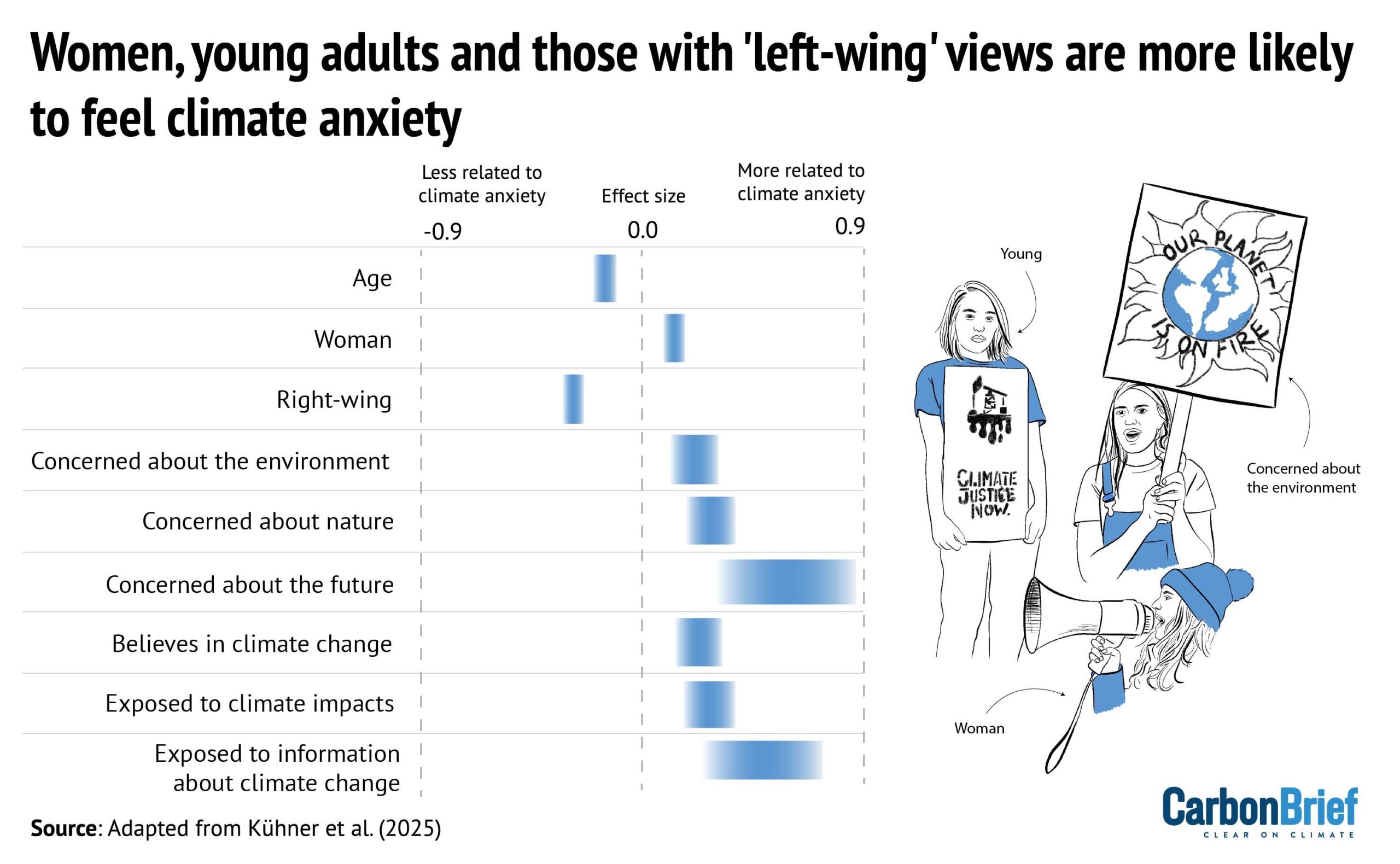
Carbon Brief’s in-depth explainer unpacked the findings of a recent analysis on climate anxiety in more detail. The analysis explored 94 studies, involving more than 170,000 participants across 27 countries, to find out who is more likely to be affected by climate anxiety and what its consequences could be. The analysis suggests that women, young adults and people with “left-wing” political views are more likely to feel climate anxiety.
Spotlight
Heat and fire in France
This week, Carbon Brief explores how France’s media has covered the impacts of recent heatwaves and wildfires.
“We’re used to high temperatures, but we’ve never experienced heat like this [so] early in the year before,” a family member who lives in the Dordogne area of southwest France explained during a recent visit to the country.
Over recent weeks, there have been extreme heatwaves and fires across Europe, which has set new records across the continent, including in France.
France is now gripped once again by extremes. The country is currently experiencing yet another heatwave and this week faced its “largest wildfire in decades”, according to France24.
French climate scientist Dr Olivier Boucher, who is also the CEO of Klima consulting, told Carbon Brief:
“Climate change is already having visible and significant impacts in France. Heatwaves are becoming more frequent, more intense, and are occurring earlier in the season.
“This trend is accompanied by an increased risk of wildfires, particularly in southern regions, though other areas are also increasingly affected, putting the built environment at risk.”
Red alerts
In July, nearly 200 schools closed or partially closed as a result of high temperatures across the country.
Since the start of the summer, water reserves have been under close surveillance and multiple areas are facing water restrictions as a result of drought.
These water restrictions can include the use of tap water and violations can incur fines of €1,500 (£1,300). According to Le Monde, more than a third of the country is under drought alerts.
France has also experienced a “devastating summer” for fire outbreaks, according to FranceInfo. Traditional firework displays celebrating France’s Bastille day on 14 July were cancelled across the country due to forest fire risks, said Le Monde.
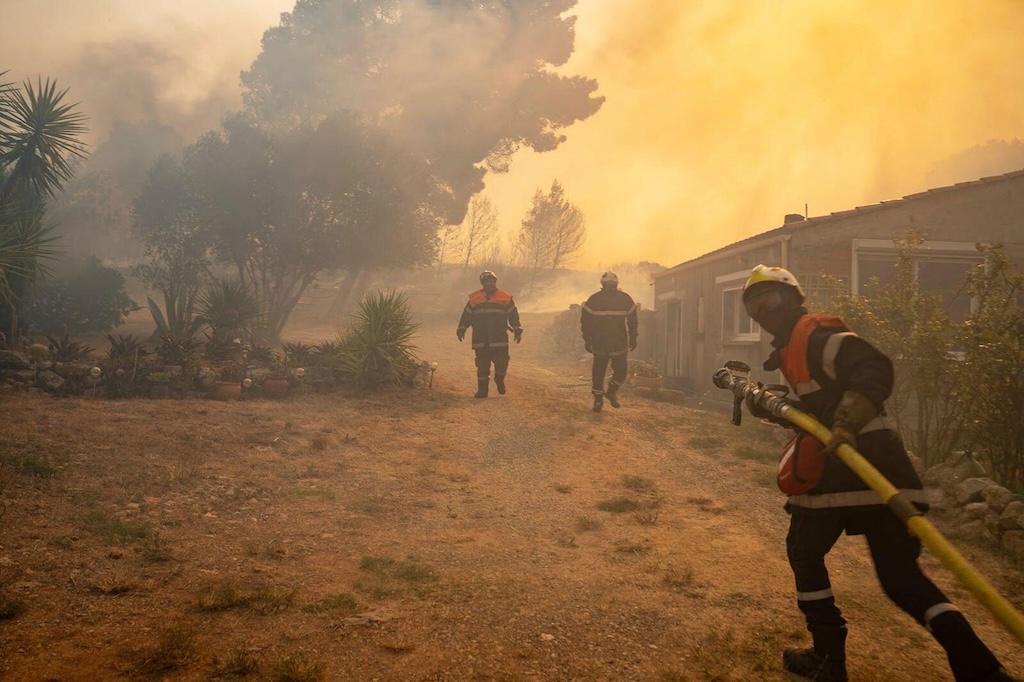
On 4 August, the local area of Aude, situated in the south-east, was placed under a red alert for forest fire risks.
Since then, there have been record-breaking fires in the region. BBC News reported that fires have “scorched an area larger than Paris”. The broadcaster added that the country’s prime minister, François Bayrou, linked the fires to global warming and drought, describing them as a “catastrophe on an unprecedented scale”.
Needing to adapt
Le Point explained how heatwaves impact grape vines and how winemakers have adapted their growing techniques by leaving more leaves on vines to protect the grapes from getting burned by the sun. However, it added that, “in the long run, it is necessary to think about more long-term modifications of viticulture”.
FranceInfo told the story of winegrowers losing their crops, worth millions of euros, in the recent fires in southern France, adding that it is “a real economic disaster for farmers affected by the flames”.
Le Monde interviewed French geographer Dr Magali Reghezza-Zitt, who described the nation’s preparations for dealing with climate change as inadequate. She told the newspaper:
“The gap between what needs to be done and the pace at which climate change is accelerating grows wider each year.”
Boucher added to Carbon Brief:
“All economic sectors are impacted by climate change, with agriculture among the most vulnerable. As the warming trend is projected to continue over the coming decades, adaptation will be essential – both through the climate-proofing of infrastructure and through changes in practices across sectors.”
Watch, read, listen
‘GRASSROOTS ALLIANCE’: A Deutsche Welle documentary explained how unions, activists and the India Meteorological Department have joined forces to protect Delhi’s informal workers from extreme heat.
NEW RULES: A Bloomberg article said that South Africa “will seek jail time, fines and higher taxes for breaches of proposed rules to govern carbon emissions” as part of new efforts to reduce the country’s dependency on coal.
SUSTAINABLE AI?: As the AI race intensifies, the Financial Times investigated if data centers can “ever truly be green”.
Coming up
- 5-14 August: Resumed talks on a global plastics treaty, Geneva, Switzerland
- 10-15 August: Ecological Society of America annual meeting | Baltimore, US
- 13-15 August: African Union-AIP water investment summit 2025 | Cape Town, South Africa
- 15 August: China Environmental Science Youth Academic Conference | Changsha, China
Pick of the jobs
- Save the Children, senior climate advisor | Salary: £61,500-£69,200. Location: London
- Irish Independent, environmental correspondent | Salary: Unknown. Location: Dublin
- Ember, interim managing director | Salary: £89,000-£100,000. Location: Remote
- British Antarctic Survey, seabird remote sensing data analyst | Salary: £41,344-£45,479. Location: Cambridge, UK
DeBriefed is edited by Daisy Dunne. Please send any tips or feedback to debriefed@carbonbrief.org.
This is an online version of Carbon Brief’s weekly DeBriefed email newsletter. Subscribe for free here.
The post DeBriefed 8 August 2025: Arctic heatwave; Climate anxiety deep-dive; France’s wildfire crisis appeared first on Carbon Brief.
DeBriefed 8 August 2025: Arctic heatwave; Climate anxiety deep-dive; France’s wildfire crisis
Greenhouse Gases
Guest post: What an ‘ambitious’ 2035 electricity target looks like for China
China’s power sector is both the world’s largest emitter and the largest source of clean-energy growth, making it essential to global climate efforts.
This means it will be a key part of China’s next nationally determined contribution (NDC) – its climate pledge under the Paris Agreement for 2035 – which all countries are expected to publish by this year.
Yet, at the same time, Chinese policymakers are grappling with perceived tensions between ensuring a reliable energy supply amid uncertain demand growth and future cost trajectories, which have the potential to weigh down climate ambition.
In our new study, co-authored with experts from Tsinghua University and published in Cell Reports Sustainability, we model pathways for China’s power system up to 2035 that are consistent with its wider climate goals, incorporating a wide range of scenarios and uncertainties currently being debated in the country.
We find that China would need to deploy 2,350-2,780 gigawatts (GW) of wind and solar by 2030 and 2,910-3,800GW by 2035 – roughly double current levels – to be consistent with a target of limiting the rise in global temperatures to 2C this century.
Furthermore, ensuring that the share of wind and solar generation reaches around 40% by 2030 and 50% by 2035 would set the power sector up for the longer-term transition to carbon neutrality by 2060.
Electricity generation from non-fossil fuels more broadly would reach around 50% by 2030 and more than 70% by 2035.
China’s climate ambitions
China’s “dual-carbon” goals, announced in 2020, aim to peak carbon emissions by 2030 and reach carbon neutrality by 2060. The country has already surpassed its 2030 renewable deployment target – 1,200GW of wind and solar – six years ahead of schedule, due to record-breaking annual additions of around 300GW of new capacity for two years in a row.
However, new coal-power developments and rapid growth in electricity demand pose a threat to meeting China’s other targets, such as emissions intensity and share of non-fossil fuel in the energy mix.
China began building nearly 95GW of new coal capacity in 2024, representing 93% of the world’s new coal capacity under construction.
If completed, China’s coal fleet – already the largest in the world – would expand to an installed capacity of 1,190GW.
This resurgence stems in large part from concerns surrounding energy security. China faced unprecedented power shortages in 2021 and 2022, while annual electricity demand has recently reached 10 petawatt-hours (PWh, or 10,000 terawatt hours) – a level that most studies predicted would not be reached until 2030.
This keeps the door open to continued growth in China’s electricity generation and emissions from coal, unless the expansion of clean energy is able to keep pace.
Setting the renewable energy pace
Our research looks at the rate of growth from clean energy that would be required to not only meet China’s rapidly rising demand for electricity, but also to push down its coal generation and squeeze emissions from the power sector.
We simulate a range of system “baselines” for 2030 and “scenarios” for 2035, under varying assumptions about electricity demand growth, carbon emissions limits, renewable energy costs and meteorological conditions.
The model includes detailed representations of where renewable energy capacity could be built and how the power sector could be operated efficiently.
It evaluates wind and solar resources and deployment potential at a level that is detailed enough to help capture regional differences and localised impacts, such as land use, socio-economic benefits and infrastructure needs.
The results are organised into 15 scenarios, categorised into three main groups: moderate growth in electricity demand (group A); rapid electrification (group B); and ambitious decarbonisation (group C).
The modelling is based around two different scenarios for China that are compatible with a global limit of 2C warming this century.
The basic 2C trajectory would see China’s power-sector emissions fall to 36% below 2024 levels by 2035, whereas the more ambitious 2C trajectory has a 42% decline.
The chart below shows recent electricity demand (left) and the carbon dioxide (CO2) emissions of China’s power sector (right), as well as how these might evolve under the different scenarios modelled for the paper.
The modelling accounts for recent trends suggesting that China’s electricity demand could reach 13.5PWh by 2035 (groups A and C). However, accommodating faster demand growth under a rapid electrification scenario (group B) would require China to deploy low-carbon energy even more rapidly, if it is to maintain pace with climate targets.
The modelling shows that wind and solar energy would need to supply around 40% of China’s electricity by 2030, if the country aims to remain on track for 2C of global warming. Solar and wind power generation would need to then rise to 50% by 2035 – up from 17.9% in 2024.
This growth would substantially reduce the system’s reliance on coal and other fossil fuels, which would decrease to 35% of generation in 2030 and 25% in 2035.
The more ambitious scenario, which targets limiting global warming since the pre-industrial period to between 1.5C and 2C, would lead to even higher wind and solar generation shares of 44% by 2030 and 54% by 2035.
Under the different scenarios, China’s wind and solar capacity would rise from around 1,700GW today to 2,350-2,780GW by 2030 and 2,910-3,800GW by 2035. Meeting this level of renewable deployment would require annual additions of 120-220GW.
Recent wind and solar additions have already exceeded this pace, but challenges with grid integration and supporting infrastructure could, nevertheless, slow future large-scale buildouts.
According to industry reports, 6.8% of wind and 6.1% of solar power generation were “curtailed” in the first four months of 2025, meaning the output could not be accommodated by the electricity grid and was wasted.
At the provincial level, wind and solar curtailment rates exceeded 10% in renewable-rich regions, such as Xinjiang, Gansu and Qinghai. To achieve the cost-efficient pathways modeled here, curtailment rates fall to 3-6%.
To achieve this level of integration, energy storage and transmission infrastructure will be necessary to shift renewable generation towards when and where it is needed.
Battery and grid capacity would need to rise by 6% and 5% per year from current levels out to 2035, respectively, in order to better integrate renewables into the grid.
Boosting wind and solar generation share
In order to explore the implications of uncertainty on China’s power system in 2030, the modelling includes three core scenarios (groups A-C).
Within these core groups, the modelling looks at the impact of further uncertainties on system outcomes by 2035, labelled A1, A2 and so on. This results in a “decision-tree” structure that outlines a range of possible futures.
The lines on the chart below show the share of China’s electricity that would be generated by wind and solar by 2030 and 2035, under each of these different futures. The coloured columns show the share of electricity generated by wind (red), solar (yellow), hydro (blue), nuclear (pink) and biomass (grey) in one specific scenario, namely, the “reference” case for renewable costs with moderate demand growth (A1).
The bands in the right-hand margin indicate the ranges of the 2035 results under all of the future scenarios, depending on variables such as the cost of renewables or batteries (cases two to four) and a larger rise in demand (case five).
At a minimum, for each of the 2C-compatible scenarios, wind and solar would take up around 50% of total generation by 2035.
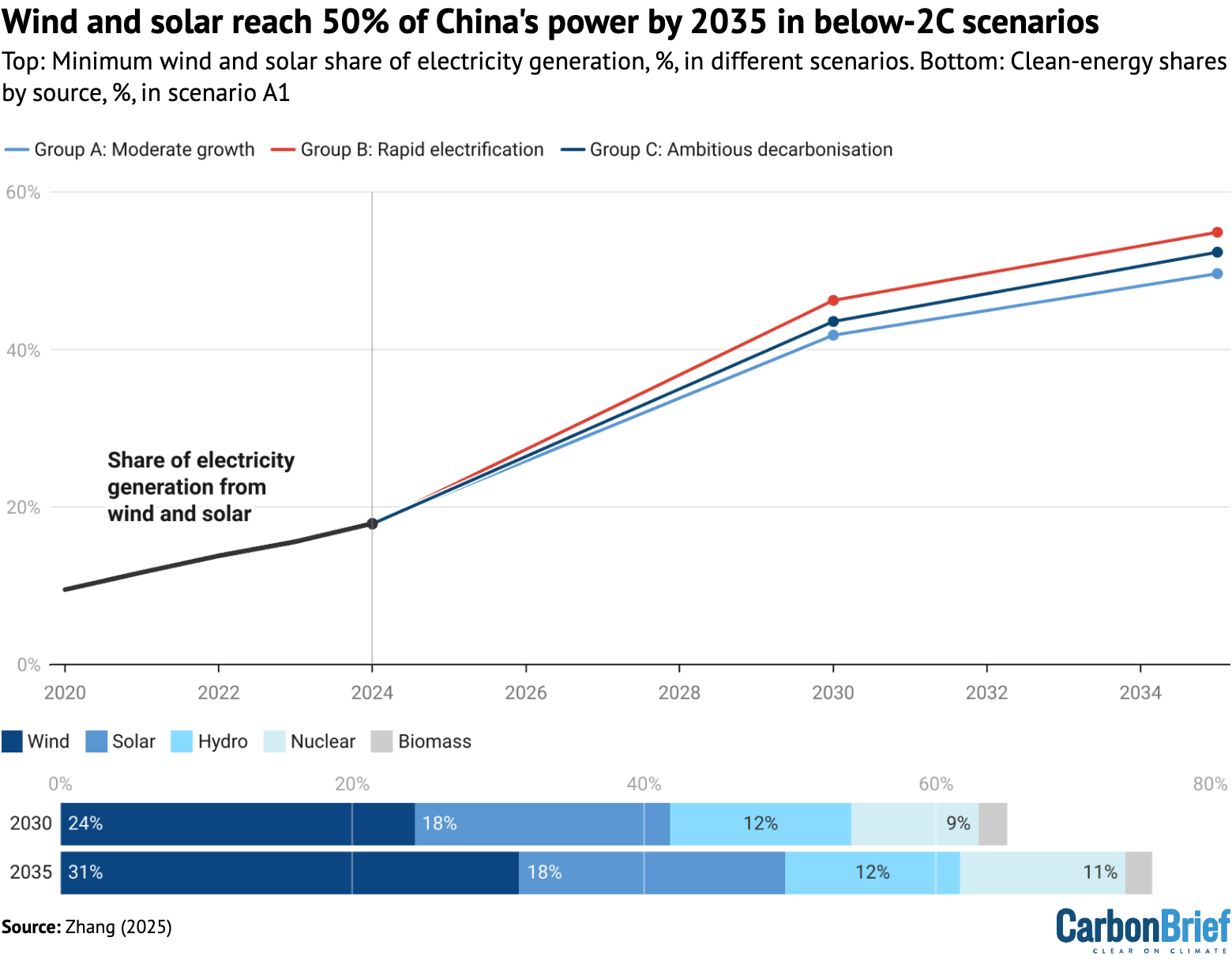
Another consistent result across all scenarios is the need for more transmission capacity to shift generation from renewable-rich regions to those with high demand for power. By 2030, at least 225GW of new inter-provincial transmission capacity would be required, further enhancing electricity trading and grid reliability.
China is already expanding its “ultra-high-voltage” (UHV) transmission network at breakneck speed. As of the end of 2024, there were 42 UHV projects in operation, with a combined capacity exceeding 300GW.
Another assumption in the modelling is that electricity can flow freely and efficiently across regions, up to the transmission capacity limits. But, in reality, institutional and regulatory barriers complicate regional electricity trading.
China plans to establish a national unified power market by 2029. As such, deregulating the power sector is seen as an essential measure to enhance the power system’s operational efficiency and facilitate renewable energy integration.
Looking ahead to the NDC and beyond
Many experts have weighed in on China’s NDC target-setting, largely focusing on economy-wide emissions targets and non-CO2 greenhouse gases.
While these are indeed important elements of China’s next international climate pledge, our study seeks to identify robust power-sector targets that could support the country’s overall ambition and provide credible signals to energy planners.
Due to the rapidly evolving economic and geopolitical situation, there are good reasons to expect that China’s topline emissions number may be underwhelming.
On the other hand, there is an opportunity to emphasise and expand ambition within the power sector through additional sectoral targets. This would put a focus on quantifiable metrics that can guide investments and planning by state-owned enterprises and local governments.
While China has previously set a target for the absolute capacity of wind and solar, a goal for the share of electricity generation from these technologies, or for clean energy more broadly, would set a narrower range for future emissions from the power sector.
Given current uncertainties around the pace of power demand growth, for example, a target for clean energy share might provide greater confidence to policymakers than a capacity target alone.
Regardless of what targets are set, achieving the growth of clean energy modelled in our study would support China’s long-term climate commitments and demonstrate the nation’s intent to be a clean-energy powerhouse.
The post Guest post: What an ‘ambitious’ 2035 electricity target looks like for China appeared first on Carbon Brief.
Guest post: What an ‘ambitious’ 2035 electricity target looks like for China
-
Climate Change2 years ago
Spanish-language misinformation on renewable energy spreads online, report shows
-
Climate Change Videos2 years ago
The toxic gas flares fuelling Nigeria’s climate change – BBC News
-

 Greenhouse Gases1 year ago
Greenhouse Gases1 year ago嘉宾来稿:满足中国增长的用电需求 光伏加储能“比新建煤电更实惠”
-

 Climate Change1 year ago
Climate Change1 year ago嘉宾来稿:满足中国增长的用电需求 光伏加储能“比新建煤电更实惠”
-

 Carbon Footprint1 year ago
Carbon Footprint1 year agoUS SEC’s Climate Disclosure Rules Spur Renewed Interest in Carbon Credits
-
Climate Change2 years ago
Why airlines are perfect targets for anti-greenwashing legal action
-
Climate Change Videos2 years ago
The toxic gas flares fuelling Nigeria’s climate change – BBC News
-
Climate Change2 years ago
Some firms unaware of England’s new single-use plastic ban












